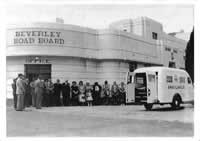Council History
 Local Government control in Beverley has been traced back to 1843 when an Act was passed "to provide for the Construction and Management of roads and other National Communications in the Colony". A local board of directors was appointed to provide a voice on district works, particularly road construction. Formal establishment of what is now known as the Shire of Beverley occurred in 1871 with the creation of the Beverley Roads Board. The original area was immense even by today's standards. The western and northern boundaries of the district were similar to what they are today, but the area continued much further to the east all the way to Eucla on the Great Australian Bight some 1200 kilometres away! However, the boundaries changed frequently and by 1923 the boundaries that exist today were established.
Local Government control in Beverley has been traced back to 1843 when an Act was passed "to provide for the Construction and Management of roads and other National Communications in the Colony". A local board of directors was appointed to provide a voice on district works, particularly road construction. Formal establishment of what is now known as the Shire of Beverley occurred in 1871 with the creation of the Beverley Roads Board. The original area was immense even by today's standards. The western and northern boundaries of the district were similar to what they are today, but the area continued much further to the east all the way to Eucla on the Great Australian Bight some 1200 kilometres away! However, the boundaries changed frequently and by 1923 the boundaries that exist today were established.
In 1895, the East Beverley Roads Board was formed. This authority included the eastern part of the current Shire area as well as parts of the current Shires of Quairading, Brookton and Pingelly. In 1906 the East Beverley Roads Board was disbanded with its area divided into the newly formed Roads Boards centred on Quairading, Brookton and Pingelly.
To add to the confusion of frequent changes, between c.1892 and 1913 the Beverley townsite had its own Local Government known as the Beverley Municipal Council. This was a completely separate authority from the Roads Board with both having separate offices in Vincent Street near the Avon River Bridge - both buildings survive today. During 1913, the Beverley Municipal Council was reintegrated into the Beverley Roads Board.
There was a fairly stable period of growth in the Roads Board between the 1920's and early 1960's. In 1960 the Roads Board was made up of 8 elected members and an appointed Secretary. As the community grew, so to did the functions of the Board. Originally established to make sure adequate roads were provided to support the growing farming community, the Board began to get involved in all manner of issues, such as rabbit control and the provision of public facilities, including the town hall, swimming pool and recreation grounds.
With the passing of the Local Government Act 1960, all Road Boards were reorganised as local government authorities with 8 Councillors replacing the Board Chairman and Board Members. The Shire Clerk replaced the Secretary of the Board. About this time the newly named Shire of Beverley moved from a rather cramped office space in the Town Hall, which had been constructed in 1937, to the former headmaster's house next door at 136 Vincent Street, which had been modified to suit its new purpose.
In 1989, the current Shire Office and Chambers was constructed on the same site as the old office, which had again become too small. At this time the number of Councillors was increased to its current level of 9 representing 3 wards - North, West and South. Further changes to how local government runs in WA occurred in 1995 with the passing of the new Local Government Act. One of the interesting changes was the renaming of the Shire Clerk position as a Chief Executive Officer - reflecting the gradual increase in the importance and complexity of this role.